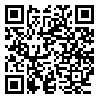Volume 8, Issue 1 (Continuously Updated 2025)
Func Disabil J 2025, 8(1): 0-0 |
Back to browse issues page
Download citation:
BibTeX | RIS | EndNote | Medlars | ProCite | Reference Manager | RefWorks
Send citation to:



BibTeX | RIS | EndNote | Medlars | ProCite | Reference Manager | RefWorks
Send citation to:
Farazi M, Aali N, Akhvan Hejazi S M. Rehabilitation of Speech and Swallowing Disorder in a Patient With Severe Brain Injury in the Subacute Phase: A Case Report. Func Disabil J 2025; 8 (1)
URL: http://fdj.iums.ac.ir/article-1-294-en.html
URL: http://fdj.iums.ac.ir/article-1-294-en.html
1- Department of Speech Therapy, School of Rehabilitation Sciences, University of Social Welfare and Rehabilitation Sciences, Tehran, Iran.
2- Brain and Spinal Cord Injuries Ward, Rofeideh Rehabilitation Hospital, Tehran, Iran.
2- Brain and Spinal Cord Injuries Ward, Rofeideh Rehabilitation Hospital, Tehran, Iran.
Abstract: (1182 Views)
Background and Objectives: Swallowing disorder or dysphasia is often due to neuromuscular brain damage. Dysarthria is a speech movement disorder caused by damage to the central nervous system. Dysarthria may impair the respiratory, articulation, phonation, resonance, or prosody system. This study aims to investigate the rehabilitation of speech and swallowing disorders in a patient with severe brain injury in the subacute phase.
Case Presentation: The patient was a 13-year-old child who suffered from a traumatic brain injury (TBI); the anatomical and physiological condition of the swallowing mechanism may be disturbed. Based on the evaluation by neurologists and physical examination, according to the Rancho Los Amigo Scale, he was placed at level 4 and severely impaired in cognitive speech and brain function. After being evaluated by the treatment team, he underwent rehabilitation interventions. The multiple professional team includes physicians, nurses, speech and language pathologists, and clinical dietitians. He also suffered a fracture in the left clavicle after the accident. The treatment team took about three and a half months to treat the patient in this hospital.
Conclusion: After 40 days of continuous rehabilitation, the patient’s swallowing problems were resolved. The patient had acquired the ability to swallow solids and liquids naturally. Also, after 90 days, the patient could speak well, his speech being clear and with adequate breathing capacity.
Case Presentation: The patient was a 13-year-old child who suffered from a traumatic brain injury (TBI); the anatomical and physiological condition of the swallowing mechanism may be disturbed. Based on the evaluation by neurologists and physical examination, according to the Rancho Los Amigo Scale, he was placed at level 4 and severely impaired in cognitive speech and brain function. After being evaluated by the treatment team, he underwent rehabilitation interventions. The multiple professional team includes physicians, nurses, speech and language pathologists, and clinical dietitians. He also suffered a fracture in the left clavicle after the accident. The treatment team took about three and a half months to treat the patient in this hospital.
Conclusion: After 40 days of continuous rehabilitation, the patient’s swallowing problems were resolved. The patient had acquired the ability to swallow solids and liquids naturally. Also, after 90 days, the patient could speak well, his speech being clear and with adequate breathing capacity.
Type of Study: Case Report |
Subject:
Speech Therapy
Received: 2024/10/31 | Accepted: 2024/12/2 | Published: 2025/03/22
Received: 2024/10/31 | Accepted: 2024/12/2 | Published: 2025/03/22








